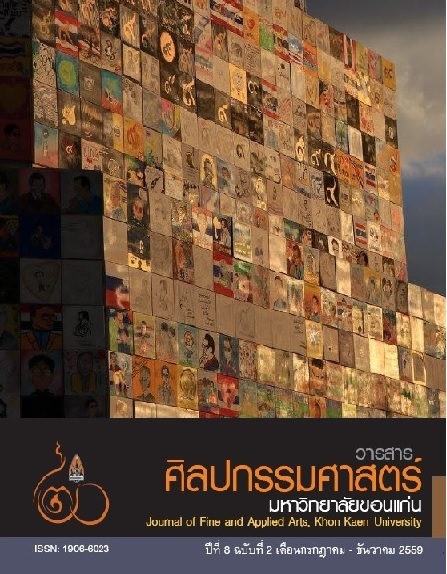การออกแบบงานวิจัยทางนาฏยศิลป์ กรณีศึกษาการสร้างงานนาฏยศิลป์ไทยเพื่อการอนุรักษ์และสร้างสรรค์สำหรับคนรุ่นใหม่ Research design of Dance : Thai Dance Creation Using Conservation and Creative Ideas for the New Generation
Main Article Content
Abstract
การอออกแบบการวิจัยเป็นขั้นตอนหนึ่งที่สำคัญที่ช่วยผู้วิจัยให้สามารถวางแผน กำหนดโครงสร้าง และวิธีการต่างๆ เพื่อให้ได้คำตอบของการวิจัยอย่างชัดเจน โดยเฉพาะการทำวิจัยเกี่ยวกับงานนาฏยศิลป์ที่สามารถวางแผนได้หลากหลายขึ้นอยู่กับกรณีที่ศึกษา จึงเลือกใช้เครื่องมือต่างๆในการปฏิบัติการวิจัยได้หลายวิธี จากหลายเครื่องมือ โดยบทความนี้ได้ใช้กรณีศึกษาจากงานวิจัยเรื่องการสร้างงานนาฏยศิลป์ไทยเพื่อการอนุรักษ์และสร้างสรรค์สำหรับคนรุ่นใหม่ นำมาเป็นตัวอย่างประกอบการอธิบายเพื่อให้เกิดความเข้าใจได้ดียิ่งขึ้น ซึ่งงานวิจัยดังกล่าวได้ออกแบบการวิจัยให้ใช้เครื่องมือต่างๆ ได้แก่ 1) การสำรวจข้อมูลเชิงเอกสาร 2) ร่วมสัมมนา 3) การทำการแสดงซ้ำ โดยทดลองสร้างการแสดงชุด “เพนดูลัม” ขึ้นใหม่และประเมินผลเพื่อหาวิธีการทำงาน 4) สัมภาษณ์ผู้ทรงคุณวุฒิ ผู้เชี่ยวชาญ ผู้แสดงและบุคคลอื่นๆที่เกี่ยวข้อง 5) สื่อสารสนเทศอื่นๆที่เกี่ยวข้อง 6) การสำรวจข้อมูลภาคสนาม 7) การทดลองสร้างผลงานการแสดงเพื่อทดสอบแนวคิด 8) เกณฑ์มาตรฐานศิลปินทางด้านนาฏยศิลป์ ทั้งนี้ยังนำตัวอย่างขั้นตอนการปฏิบัติการวิจัยมาประกอบเพื่อให้เห็นถึงความเชื่อมโยงของการออกแบบการวิจัยด้วย
เมื่อการออกแบบการวิจัยสอดคล้องกับวัตถุประสงค์ของการวิจัย ย่อมส่งผลให้คำถามการวิจัยที่ถูกตั้งขึ้นสามารถตอบประเด็นปัญหา นำมาซึ่งผลของการวิจัยที่ตรงตามวัตถุประสงค์ของงานวิจัยนั่นเอง
Research design is one of the most significant steps in carrying out a research project because it allows a researcher to formulate a plan, structure, and a method. Research in dance can be plotted in many ways it depends upon a case study of each individual project which can be drawn upon a variety of methods and several types of tools. This article is based upon a research project that employs a case study of conserving and promoting a creative work of Thai dance for a new generation. The inquiry deals with a research process including the following: (1) document survey; (2) organizing a seminar; (3) reproducing “Pendulum” with a post-production evaluation; (4) interviewing experts, dancers; and related individuals, (5) surveying interactive-media on the subject, (5) conducting a fieldwork; (6) a production and experimentation of a performance to test a hypothesis; and (7) applying a set of standardized criteria for dance artists. All seven methods are shown in the article as an example of a coherent research design.
When a research design complies with research objectives, research findings will be precisely obtained according a set of research questions.
Article Details
Content and information in articles published in the Journal of Fine and Applied Arts of Khon Kaen University is regarded as the opinion and sole responsibility of the author(s) directly; therefore, editors are not obliged to agree to or share any responsibility with regard to the content and information that appears within these articles.
All articles, information, content, image, etc. that have been published in the Journal of Fine and Applied Arts of Khon Kaen University is the copyright of the Journal of Fine and Appllied Arts of Khon Kaen University. Any person or organization who wishes to distribute all or parts of the articles for further dissemination or other usage must first receive permission from the Journal of Fine and Applied Arts of Khon Kaen University before proceeding to do so.


